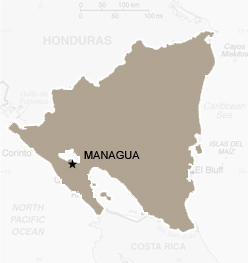Nicaragua
L'accès à l'eau potable 79%
L'alphabétisation des adultes 67.02%
Mortalité des moins de 5 ans 25.5 per 1,000 live births
-
Fiche d'information du pays
-
Nos Programmes conjoints
Democratic economic governance in the Water and Sanitation sector in the RAAN and RAAS
Less than 20% of people living in Nicaragua's Northern and Southern Autonomous Administrative Regions, home to many indigenous communities, have access to drinking water and adequate sanitation. The goal of the Joint Programme was to increase sustainable access to water and sanitation for poor population groups by strengthening democratic economic governance in the water and sanitation sector.
“TUKTAN YAMNI” Integrated Model
This Joint Programme's goal was to reduce chronic malnutrition in Nicaragua's Northern and Southern Autonomous Administrative Regions, home to many indigenous communities, by providing pregnant and breastfeeding women, children under five and school children up to 12 with integrated food security and nutrition services.
Local and regional environmental management for the management of natural resources and provision of environmental services
Nicaragua's Bosawas Biosphere Reserve is Central America's largest rainforest and part of the Mesoamerican Biological Corridor. The Joint Programme's aim was to improve management of the protected area, increase access to water and sanitation, provide renewable energy and promote agroforestry as a means to boost incomes.
National Development Capacities for Improving Employment and Self-Employment Opportunities for Young People
This Joint Programme worked with the government to improve young Nicaraguans' access to decent employment, especially those living in socially vulnerable conditions in urban and rural areas, and thereby helped to counteract the negative effects of migration.
“From Rhetoric to Reality”: Promoting Women’s Participation and Gender Responsive Budgeting
Women in Nicaragua face limited access to decent work and credit, low participation in decision-making, little economic autonomy, poor exercise of their rights, including sexual and reproductive, and poor access to justice in cases of domestic violence. This Joint Programme was designed to support the government in ensuring the equality of women and men and enforcing non-discrimination on the grounds of gender.
Cultural Recovery and Creative Productive Development on the Caribbean Coast of Nicaragua
One in three children is chronically malnourished on Nicaragua's Caribbean Coast, an area that contains 80% of the country's natural resources, but is also one of its poorest regions and home to the majority of its indigenous and Afro-Caribbean populations. The aim of the Joint Programme was to help to reduce inequalities in the human, social and economic development of these communities through cultural reclamation, productive development and a deepening of knowledge of tangible and intangible heritage.




 This Fact Sheet summarizes the key achievements of the Joint Programmes in Nicaragua.
This Fact Sheet summarizes the key achievements of the Joint Programmes in Nicaragua.